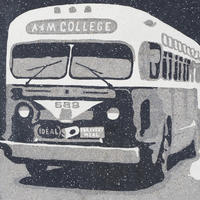
tribute to Tallahassee's 1956 bus
boycott. The panel was created
by Florida State's Master
Craftsman Studio.
Fifty-eight civil rights activists from Tallahassee were honored Sept. 30 with the unveiling of a commemorative sidewalk panel made by artisans at Florida State University’s Master Craftsman Studio.
Florida State University student Lyrica Peterson was part of the craftsman team that helped construct the panels on the Heritage Walk.
“I’m proud to now be a part of keeping the civil rights movement’s history alive,” Peterson said. “Everybody who walks here will know the importance of Tallahassee’s involvement in the civil rights movement.”
The Tallahassee-Leon County Civil Rights Heritage Walk is a series of terrazzo panels laid in the sidewalk along Jefferson Street near Monroe Street in front of the former site of McCrory’s, a five-and-dime store. Sixteen panels weighing between 800 and 2,200 pounds each tell the story of local “foot soldiers,” or activists, who participated in Tallahassee’s 1956 bus boycott and the lunch counter sit-ins of the 1960s.
Rev. Henry M. Steele was one of these foot soldiers. He said he can recall having strategy sessions before he and his brothers participated in the very first picket line and sit-in demonstrations in Tallahassee.
“We walked, we marched, we prayed,” Steele said. “We’d do roles, practicing sit-ins, practicing people knocking you on the head or blowing smoke in your face. It was not easy. It was a sacrifice.”
Hosted by the Tallahassee Community Redevelopment Agency, the City of Tallahassee and Leon County government officials, the ceremony also was attended by Mayor John Marks, who reminded the packed house that some of these foot soldiers spent 49 days in the Leon County Jail for their participation in the sit-ins.
“These individuals all have a brave story to be told,” Marks said.
After each foot soldier was recognized at City Hall, activists got to take a walk in their own footsteps along the Heritage Walk.
“The committee envisions that many scholars, students, and visitors in days, months, and years to come, will come to this monument and want to know more — more about each life,” said Althemese Barnes, founder and executive director of the John G. Riley Center.

The project involved many organizers, including the Tallahassee-Leon County Planning Department, a citizen’s advisory committee and Florida State history Associate Professor Jennifer Lisa Koslow, one of the researchers on the committee.
It was staff and student interns at the university’s Master Craftsman Studio who got their hands dirty, mixing thousands of pounds of concrete by hand. Phil Gleason was the studio manager on the job. Constructing the panels was an eye opening, powerful experience, he said, one that gave him a new appreciation for the brave locals honored in the memorial.
“We had civil rights events here that no one realizes,” Gleason said. Calling attention to local events like the bus boycott is an important educational endeavor, he said.
“I feel like we’re continuing the efforts of what happened in the ’60s.”
Heritage Walk panel images include song lyrics and a bus with “A&M College,” a reference to what is now Florida A&M University, on its front. More than 50 civil rights activists are honored with brass footsteps bearing their names. Bronze plaques, also set into the sidewalk, tell the stories behind the images.
The memorial marked the first time the studio worked with terrazzo, a composite material made of concrete and mixed aggregate such as marble, granite, quartz and other tiny flecks, all polished into a smooth surface. Gleason said the terrazzo allowed for the use of a gray color scale. The artisans printed the panels’ images to use as maps while casting the panels upside down in box molds. Gleason enjoyed the process.
“We were able to do more than we thought originally” with the material, he said.
The sidewalk memorial will be illuminated at night by solar lights incorporated into the panels.
“We’re thrilled with their work,” said Roxanne Manning with the Tallahassee Community Redevelopment Agency, which funded the sidewalk project.




